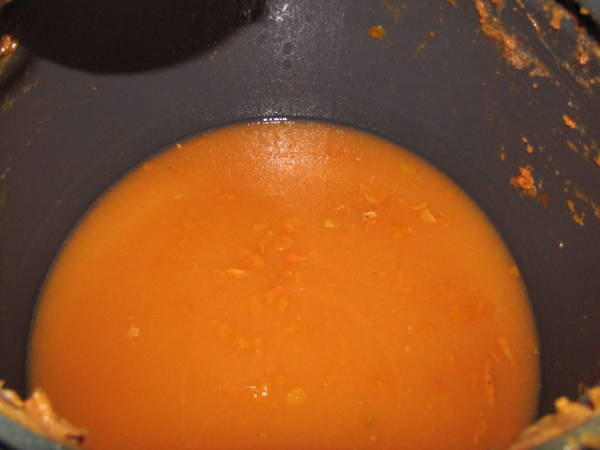Last week, under the cover of darkness, D and I scraped off the layer of pulp that had floated to the top of the barrels. The plan was that we would press the pulp with one of the methods mentioned above. We were both very curious what we would find. We knew we had liquid in there somewhere, but how much and how well it was separated from the pulp, we didn't know. This is what it looked like initially:
I don't know how evident it is in the picture, but, it was pretty thick. The first bucketful was so obviously dry that there was no point in pressing it.
After filling the bucket twice it was apparent that we were pretty close to the liquid. The third bucked was wet enough that we could have pressed some liquid out, but it was raining and we were feeling pretty good about how much liquid we were going to have. You can get a good sense of how the pulp and liquid had separated from this picture here:
After less than 4 buckets of pulp, we were done, and were left with about 40 gallons of liquid per barrel. This is what the barrel that had no sugar added looked like afterward:
The two barrels were mostly the same, except that toward the end of straining the pulp off the barrel that had sugar added, something strange happened. I can only describe it as "turning over" as though there was some pulp that had somehow been trapped on the bottom. After it "turned" the liquid was quite a bit thicker. We left both barrels and since then the one that didn't have sugar added has settled and looks like we might be nearly ready to rack. The one that did have sugar added started to show signs of fermentation again and some pulp had floated to the top. We'll let that one go for a while before straining again.
Other than a somewhat funky smell, I am very happy with how this is turning out...our yield has been great and the amount of work hasn't been that bad considering how much fruit we have.













































![Craft A Brew - Safale BE-256 Yeast - Fermentis - Belgian Ale Dry Yeast - For Belgian & Strong Ales - Ingredients for Home Brewing - Beer Making Supplies - [3 Pack]](https://m.media-amazon.com/images/I/51bcKEwQmWL._SL500_.jpg)




















